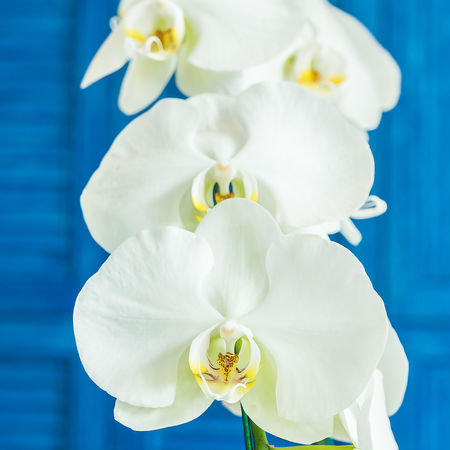
PHALAENOPSIS (Fayl-eh-NOP-siss)
Phalaenopsis, the moth orchid, is perhaps the best orchid for growing in the
home, and is also a favorite with greenhouse growers. Well-grown plants can
flower often, sometimes with a few flowers throughout the year, though the main
season is late winter into spring. Average home temperatures and conditions are
usually sufficient. Flower stems on certain hybrids can be forced to rebloom by
cutting the tip off after the initial flowering. Only healthy plants should be induced
to flower repeatedly. Based on DNA analyses, the former genera Doritis
and Doritaenopsis are now synonyms with Phalaenopsis and should be grown
similarly.
LIGHT is easy to provide for phalaenopsis. They grow easily in a bright window, with little or no sun. An east window is ideal in the home; shaded south or west windows are acceptable. In overcast, northern cattleyas. This can be provided in the winter climates, a full south exposure may home by placing the plants on trays of be needed. Artificial lighting can easily be provided. Four fluorescent tubes in one fixture supplemented by incandescent bulb, or the equivalent in LED bulbs, placed 6 to 12 inches above the leaves for 12 to 16 hours a day follows the natural day length. In a greenhouse, shade must be given; 70 to 85 percent shade, or between 1,000 and 1,500 foot-candles is recommended. No shadow should be seen if you hold your hand one foot above a plant's leaves.
TEMPERATURES for phalaenopsis should usually be above 60 Fat night, and range between 75 and 85 For more during the day. Although higher temperatures force faster vegetative growth, higher humidity and air movement must accompany higher temperatures, the recommended maximum being 90 to 95 F. Night temperatures to 55 F are desirable for several weeks in the autumn to initiate flower spikes. Fluctuating temperatures can cause bud drop on plants with buds ready to open.
WATER is especially critical for phalaenopsis. Because they have no major water-storage organs other than their leaves, they must never completely dry out. Plants should be thoroughly watered and not watered again until nearly dry. In the heat of summer in a dry climate, this may be every other day; in the winter in a cool northern greenhouse, it may be every 10 days. Water only in the morning so the 12/22 gravel, only partially filled with water so that the plants do not sit in the water. Air should always be moving around the plants to prevent fungal or bacterial disease, especially if high humidity or cool temperatures exist. In the greenhouse, the humidity is best increased by use of a humidifier. Evaporative cooling increases humidity while cooling the air.
FERTILIZE on a regular schedule when the plants are growing, especially if the weather is warm. Twice-a-month applications of high-nitrogen fertilizer (such as 30-10-10) are appropriate where bark-based media are used. Otherwise, a balanced fertilizer is best. When flowering is desired, a high-phosphorus fertilizer such as 10-30-20) can be applied to promote blooming. Some growers apply fertilizer at one-quarter strength with every watering; this is best for warm, humid conditions. With cooler or overcast conditions, fertilizer should be applied twice per month at weak strength.
POTTING is best done in the spring, immediately after flowering. Phalaenopsis plants must be potted in a porous mix. Potting is usually done every one to three years. Mature plants can grow in the same container until the potting medium starts to decompose, usually in two years. Root rot occurs if plants are left in a soggy medium. Seedlings usually grow fast enough to need repotting yearly, and should be repotted in a fine-grade medium. Mature plants are potted in a mediumgrade mix. To repot, trim soft, rotted roots and spread the remaining roots over a handful of medium in the bottom of a new pot. Fill the rest of the pot with medium, working it among the roots so that the junction of the roots and the stem is at the top of the medium.
Information gathered from the American Orchid Society www.aos.org




